The North Face Trail Lite 2-Person Tent review: lightweight, hassle-free and sturdy
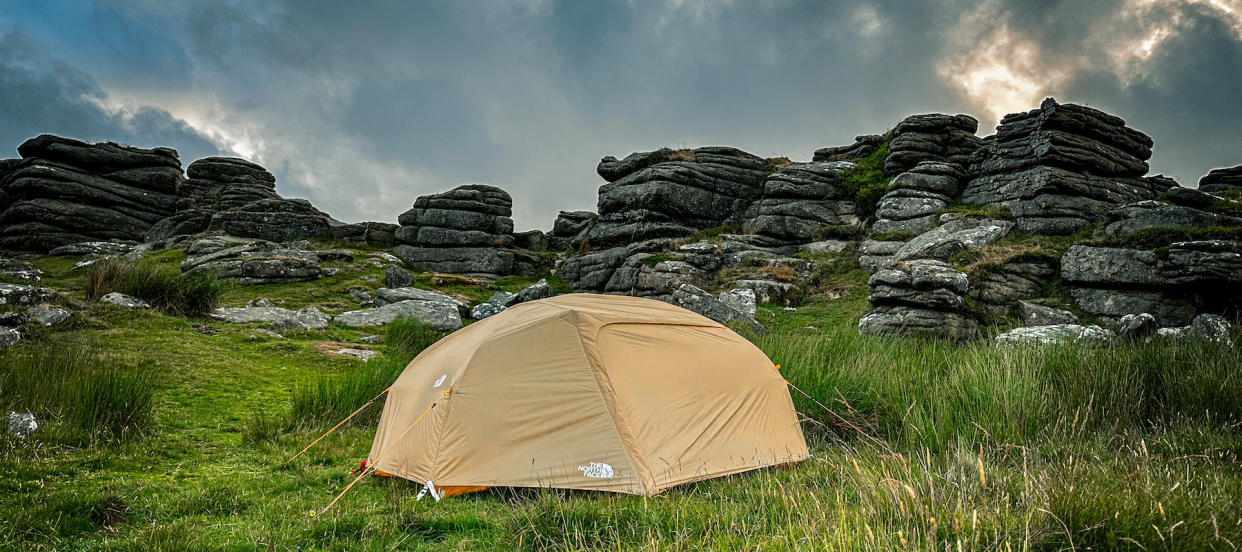
The North Face Trail Lite: first impressions
The North Face Trail Lite 2 is a lightweight two-person tent for backpacking from the outdoor powerhouse brand. It is a cleverly designed dome tent that offers maximum space for two backpackers, while still being small and lightweight enough to easily carry over long distances. It comes with two doors and two reasonably-sized vestibules, as well as a host of smart storage pouches for keeping things tidy inside. It’s also incredibly easy to pitch and pack away, and does a surprisingly good job in changing weather conditions.
Specifications
• List price: $300 (US) / £360 (UK)
• Style: Free-standing dome tent
• Weight: 2.01 kg / 4.43 lbs
• Waterproofing: 1,200mm on the fly, 5,000mm on the bathtub floor
• Rooms: One bedroom, two porches
• Compatibility: Comfortably sleeps two people and gear
Weighing pretty much bang on 2 kg (4.43 lbs), the Trail Lite 2 is reasonably lightweight, especially considering the versatile environments this thing excels in. And while 2kg might seem like a lot for a dome-style backpacking tent (the Hubba Hubba NX, the equivalent offering from MSR weighs almost 500 grams less, for example), this tent is a true two-person shelter, offering plenty of space for two people to sleep comfortably, as well as ample storage space for kit.
It also comes with an intelligently designed additional crossing pole that’s mounted off-center under the fly, serving to maximize ceiling space while providing support for some huge storage pockets above the sleeping compartment.
In my opinion, these considerations make the tent one of the best options out there for duos who hike and camp together: if you split up the load, each person only has to carry 1kg each, and then you’ve got a super-comfortable, spacious and versatile shelter to use on practically any three-season backpacking trip.
The North Face Trail Lite: in the wild
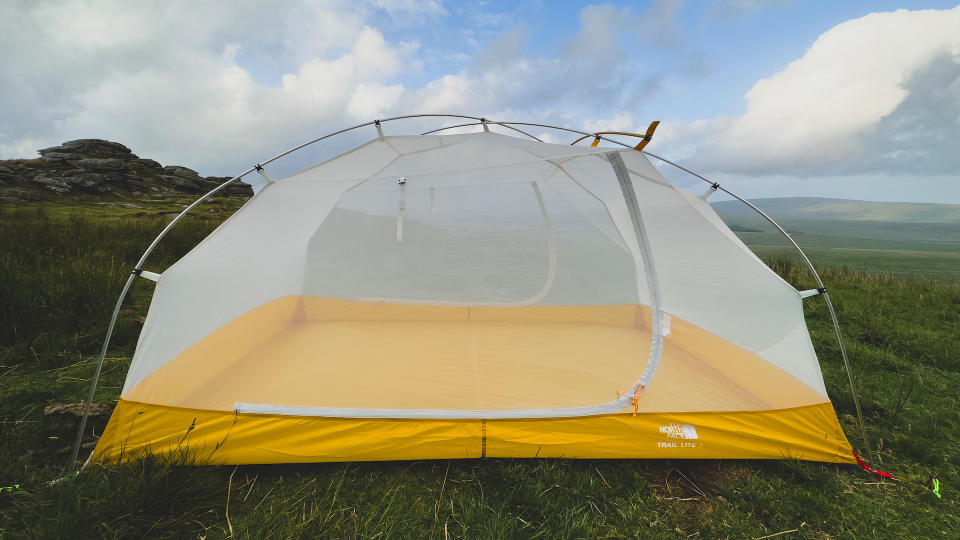
The thing that struck me most about this tent when using it for the first time was just how easy it is to pitch. It’s simply a matter of laying out the inner, inserting the poles into the four corners, clipping on the net and adding the additional crossing pole. In classic inner-first dome style, you then just drape over the fly and clip it into to each of the four corners before pegging everything out to make it drum tight. Naturally, in a summer storm, the inside is still going to get wet, but that’s a problem with all tents that you pitch inner first.
Once you’re in the tent, the number of storage pockets is impressive. You have pouches to the left and right for storing things you want in reaching distance through the night, and there are two gigantic pockets above you for keeping other bits and bobs out of the way (or for mounting a lantern). The bathtub floor is also slightly raised along the head and foot-ends of the inside to minimize drafts through the night, and all of the seams are sealed to a visibly high standard.
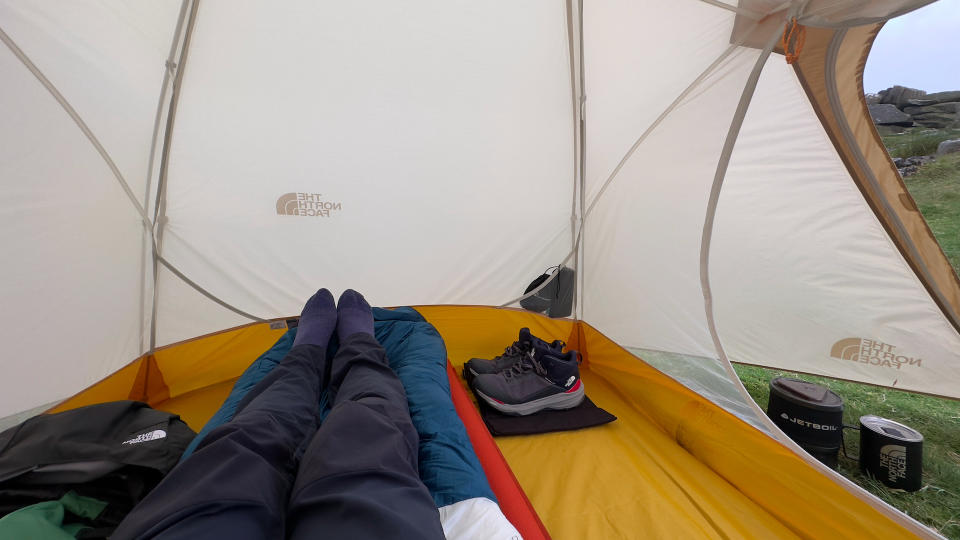
The tent has two entrances, so each user has their own door and vestibule offering a generous space to store additional kit or to cook. What’s more, the vestibule doors can be fully retracted to better allow you to enjoy the views from your tent. If it’s raining, these can be sealed shut, while a two-way zipper allows you to unzip the doors for ventilation when cooking inside.
For me, this is a nice touch, and I love having the ability to open up everything wide when the weather’s good, while still being able to zip everything back up quickly should the weather turn, as it so frequently does in the UK.
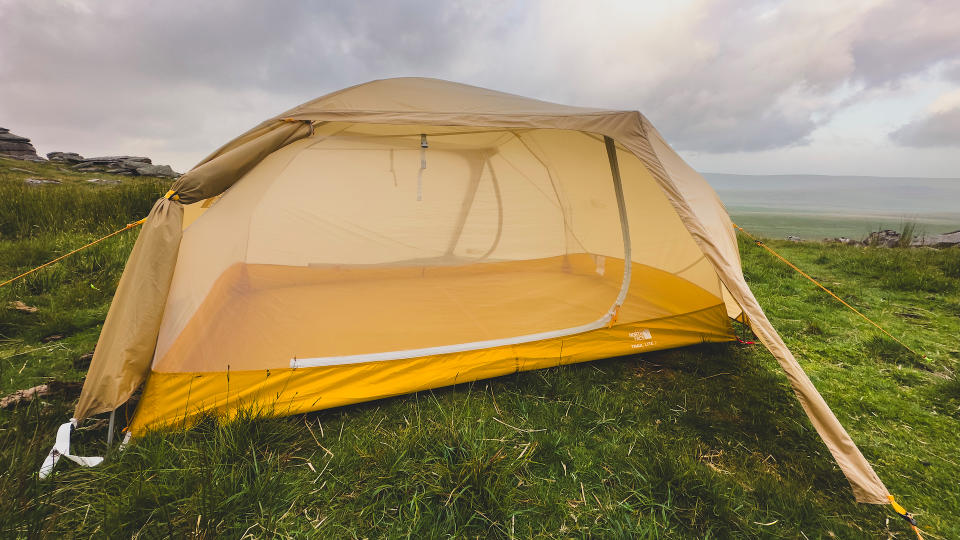
When it comes to performance in the wind, the North Face Trail Lite 2 does a lot better than you might expect, especially considering the size and shape of the walls. Truthfully, when I pitched this thing, I expected its wind tolerance to be on par with something like the Naturehike Cloud Up or the Big Agnes Fly Creek. Which is to say that my hopes weren’t very high.
To my surprise, however, the Trail Lite 2 is quite the workhorse. During one of the nights out I spent in the tent up on Dartmoor, the Trail Lite 2 confidently stood up to gusts of around 30 mph, and I’d be happy to hunker down in this tent in any three-season storm the trail throws at it. Now, that doesn’t mean it’ll cope with sustained abuse, nor is it to say that I recommend using this in a stormy conditions. But The North Face Trail Lite 2 is certainly one of the best performing lightweight backpacking tents out there for use in inclement weather.
So, what about the downsides? Well, my only gripe with The North Face Trail Lite 2 is in the number of tent pegs supplied with the tent out of the box. While the tent does come with 10 as standard, which is enough pegs to get everything up, you’re not left with any for the guy lines. And while this is a really common trend when you buy a tent – and a solid reason why you should pitch new tents at home first before taking them out wild camping – the Trail Lite 2 costs £360. This is a premium price tag for an otherwise premium quality product, so I’d love to see The North Face include four more pegs as standard, one for each of the guy lines.
Durability
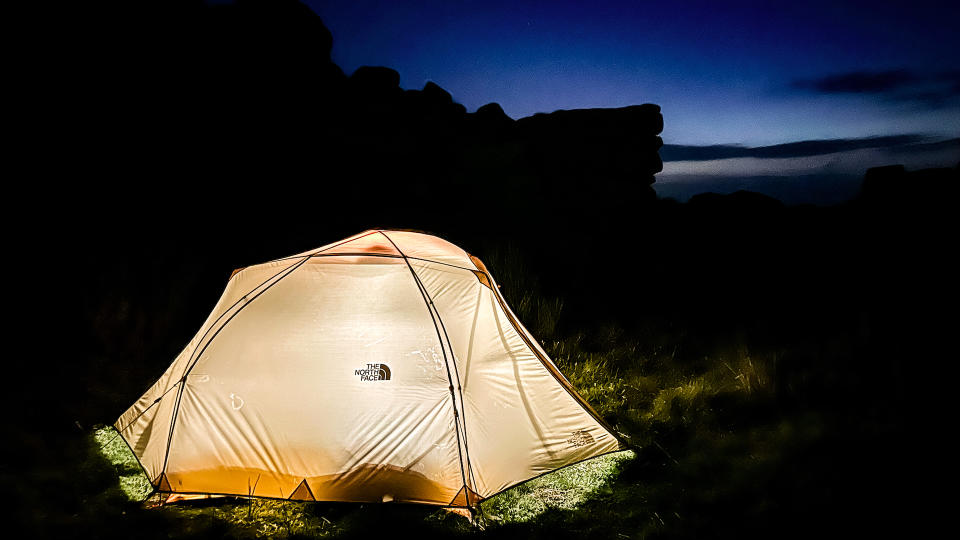
The fly on the North Face Trail Lite 2 is made of a 20D nylon ripstop fabric that’s coated with a non PFC durable water repellent coating. This makes it reliably waterproof and durable, although you’re still going to have to treat it with respect. Like any lightweight tent designed to be carried miles on the trail, the North Face Trail Lite 2 sits at the sweet spot between toughness and packability. That being said, if you treat it well, I think you’ll be able to use this versatile shelter for multiple seasons – if not for life.

